Review of HTC Aria (Gratia) Smartphone
This is a review of HTC Aria released for AT&T Wireless. As this is an AT&T phone, large portions of the phone menu and software were redesigned to fit the demands of this carrier and its services. We are reviewing the phone itself, not AT&T services or their implementation on this phone. These services vary from carrier to carrier, are not phone specific and therefore will not be reviewed, we will only notate their presence or absence.
Table of Contents:
- Introduction, Positioning
- Packaging, content
- Design, materials, build
- Controls, keyboard
- Size
- Display
- Battery
- Performance
- Memory
- Connectivity
- Software and Applications
- Camera
- Video
- GPS/A-GPS
- Multimedia
- Conclusion
Introduction, Positioning
I'm a big fan of small touchscreens, this is why my personal phone is Nokia 5530, which I just had to buy once I got my hands on it shortly after its release. It was small, light, touchscreen and, on paper, had everything I was looking for. While I have experienced more frustration with it than with any phone I have ever owned (it basically serves as an alarm clock now), I kept on dreaming about a similar size touchscreen with something more advanced than Symbian inside, Android for example. HTC Aria comes very close to that phone of my dreams, but, besides Aria working only on AT&T, a couple of minor deficiencies keep me from going with it.
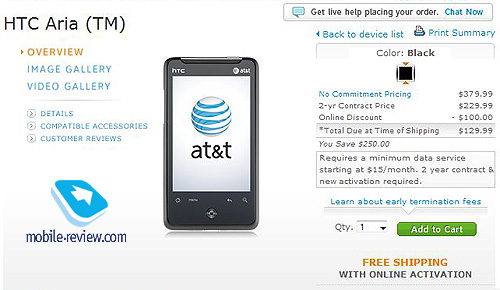
Before we get there, let's take a look at what competition Aria is stuck up against Ц other small touchscreen (3.2" LCD or less) smartphones. Let's start with AT&T network itself Ц Aria is priced at $129.99 with a 2-year contract or $379.99 without one. For the same amount of money or less you can get yourself a Palm Pre ($49.99/$399.99) or a Sony Ericsson Vivaz ($79.99/$429.99). As you can see, the competition within AT&T network uses other OS (WebOS and Symbian respectively) and is cheaper with a contract, but more expensive without one.
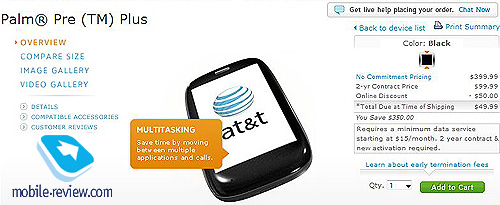
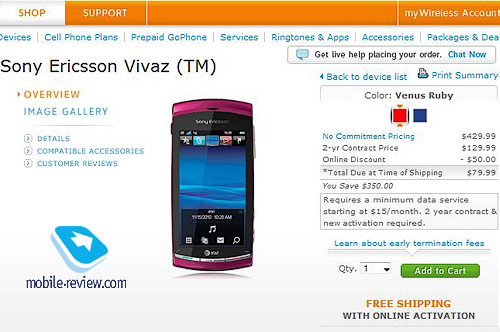
Verizon offers the same Palm Pre ($49.99/$599.99), LG Ally ($49.99/$369.99) and LG Fathom ($99.9/$379.99). Palm runs WebOS, Fathom Ц WM 6.5 and Ally "naked" Android. Ally has a better screen and a hardware shutter button, but a weaker camera (3.2MP vs. 5MP), is larger and has no HTC Sense.
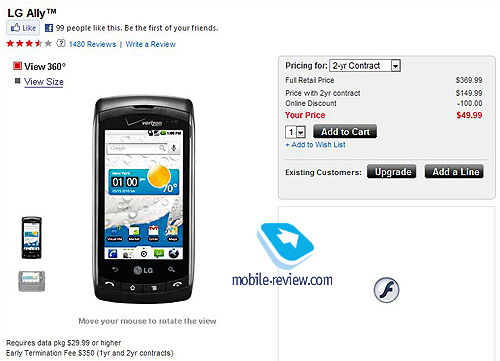
Sprint has the rugged Motorola i1 ($149.99/$349.99), aging Hero ($149.99/$429.99) and the same ever present Palm Pre ($49.99/$349.99). Both Android handsets have small screens, but are physically considerably larger than the Aria.
T-Mobile sells a variation of Hero called myTouch 3G ($99.99/$399.99), aging Samsung Behold II ($299.99/$379.99) and most importantly Nokia 5230 Nuron (Free/$179.99). Why most importantly? Because Nuron and Pre are the only full touchscreen smartphones on the major US networks that can compete with Aria size wise.
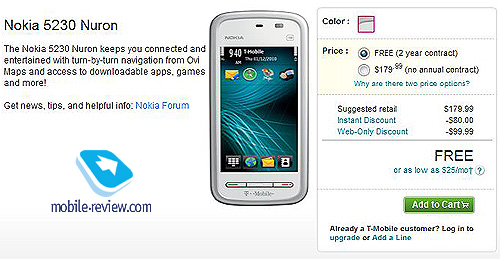
As you can see, HTC Aria, (a.k.a. HTC Liberty, a.k.a. HTC HD Mini with Windows 6.5 OS and a.k.a. recently announced for other markets HTC Gratia) has very little competition and none running Android. This puts it in a rather unique position Ц it becomes the ideal Android phone for people upgrading from a regular phone to a smartphone, who are not ready to deal with a top-of-the-line smartphones screen size and cost.
What is also interesting, is that Aria is de facto the first Android phone on AT&T network, who was so married to iPhone, it snubbed the Andy for the longest time (of course, we cannot count a thoroughly castrated Motorola Backflip as a real Android smartphone).
Back to the table of contents >>>
Packaging, content
Aria comes in a standard carton box wearing AT&T colors. Inside is the phone, a cheap stereo headset with a wired remote, a single set of foam pads for it, a good looking wall charger, USB to microUSB cable and the paperwork. The battery and an 4GB microUSB card come inserted into the phone.
Back to the table of contents >>>
Design, materials, build
The phone comes encased in rubberized black plastic (Gratia will also get the white variance). The front panel has standard piano black bezel around the LCD, but due to its smaller size the grease from the fingers is not that noticeable. The LCD itself of course attracts your fingerprints like a bank safe, but this is normal. The rubberized surface is easy to clean and for obvious reasons is not as attractive to grease. While the black plastic on the back is removed by a simple nail pull, the corners feature very stylish metal "screws", giving the phone somewhat rough looks.

Overall the design is absolutely neutral, made for everybody and no customer group in particular. The phone feels solid, well made. In four weeks I spent with it I could not see any particular places attracting dust, but depending where and how you carry it sooner or later there will be dust somewhere.


Back to the table of contents >>>
Controls, keyboard
The front houses the speaker, the LED status light flashing different colors to communicate that something is happening, i.e. there is an email in the inbox, or lit solid when the phone is charging, AT&T and HTC logos and the main Android controls Ц Home, Menu, Return and Search sensors, and an optical touchpad with press function, which I found almost useless. Not because it is bad, but because I really found very few uses for it, the phone for me was much easier and faster controlled with all the other buttons and a touchscreen.
The back houses a loudspeaker that gets badly muted if you use the phone as a speakerphone laying it on a flat surface, i.e. desk, another HTC log and a 5 MP camera with autofocus.
On the left there is only a volume control rocker.

On the right side there isЕ Nothing is on the right. A dedicated camera button is unfortunately missing and this is one of the few bad things that can be told about the Aria.

On the bottom Ц microUSB port for charging and sync.

On the top Ц a screen on/off button and a 3.5mm stereo jack.

As you can see, these are pretty much standard controls for all Android 2.1 phones, HTC in particular.
Back to the table of contents >>>
Size
As I may have mentioned before, Aria is small. I'd say, comparing with some of the top-of-the-line solutions on the market, it is tiny. AT&T lists the following specs for the phone: 4.1" x 2.3" x .46" (10.2 x 5.84 x 1.17 cm) and 4.05 oz (115 g). Did I say it is small?


Back to the table of contents >>>
Display
Aria features a 3.2" 262K TFT 320 x 480 (HVGA) LCD. Due to a smaller size, the resolution is sufficient and the screen is surprisingly good in real life. The colors are bright, it behaves decently under the sun, where the colors fade strongly but it stays legible, the angles are very good without any distortions to speak of. Overall, for a budget smartphone this is a good display and not compared side by side with an AMOLED it looks good.


Back to the table of contents >>>
Battery
This is a weak point of Aria and most HTC Android devices in general. I'm an active mobile phone user, averaging 2,000 Ц 3,000 minutes a month easily in addition to messages, emails, internet, etc. I realize that the vast majority of people use phones less, however I have to compare the Aria to other phones I used before or use now and the comparison mostly is not into Aria's favor. While it beats such HTC phones as MyTouch's 3G Slide, the 1,200 mAh Li-Ion battery is clearly not enough for a touchscreen device constantly online. On paper the battery gives up to 6 hours talk and up to 15.5 days of standby. The only thing HTC forgets to mention is that these numbers are valid only when you ride your unicorn. Outside of marketing fantasyland on average business day the phone lasted me between 8 and 12 hours, not acceptable in my book. Even if you are a lighter user, be prepared to charge it every night and do buy the car charger Ц you'll use it often. Luckily, the phone has microUSB connector for a charger, so you will likely find a cable to charge it in almost any place you go and use any computer as a charge source. The time of charging to the full is pretty standard 2-3 hours from empty. Of course, the use of power hungry applications - Wi-Fi, GPS, video shortens the battery life drastically.
Back to the table of contents >>>
Performance
Just like HTC Legend, Aria is based on Qualcomm MSM 7227 chipset with 600 MHz CPU. The processor is rather weak, but 384MB of RAM help it not to affect the speed of the device Ц the phone is fast, flying between the apps, screens and tasks. In my 2 weeks with it I was not able to find a single task it was not up to or any app that would not work immediately unless there was an AT&T network or a server delay. Even with 4-5 apps launched at the same time there was no noticeable change in speed.
Back to the table of contents >>>
Memory
There are 512MB of ROM in the phone in addition to a microSD card slot. The 16GB Lexar card used with the phone worked without any problems. The card slot is hidden under the rear cover and the cards are hot swappable.
Back to the table of contents >>>
Connectivity
Standard quadband GSM frequencies (850/900/1800/1900) and UMTS 850/1900 are supported together with Bluetooth 2.1 + EDR and Wi-Fi (802.11b/g). Bluetooth supports the following profiles pretty much standard for Android 2.1:
- Audio/Video Remote Control Profile (AVRC)
- Advanced Audio Distribution Profile (A2DP)
- Basic Printing Profile (BPP)
- Basic Imaging Profile (BIP)
- Dial-Up Networking Profile (DUN)
- File Transfer Profile (FTP)
- Hands-Free Profile (HFP)
- Headset Profile (HSP)
- Human Interface Device Profile (HID)
- Object Push Profile (OPP)
- Personal Area Network Profile (PAN)
- Phone Book Access Profile (PBA)
- SIM Access Profile (SAP)
USB 2.0 upon connection allows selecting from three modes: Charge only, Sync (contacts and calendar), Disk drive.
Bluetooth allowed me to transfer all of my contacts with pictures in a few minutes, transfer images and music files, but I was not able to send the Calendar entries.
Sync with Google services (Address Book, Calendar, etc.) is seamless.
Overall there only one problem with connectivity: a pretty slow Bluetooth connection. It took sometimes a few minutes for the phone to connect to already paired, trusted device, i.e. a car kit.
Back to the table of contents >>>
Software and Applications
The Aria runs Android 2.1 with HTC Sense on top of it, which makes it very attractive and comfortable to use. You can see the full Android 2.1 review and full HTC Sense review. They will give you a pretty full description of various software capabilities, from phonebook to a music player.
The phone comes with a number of applications preinstalled by AT&T. Some of them are great, others really depend on whether you need them. For example, like almost any Android 2.1 phone on the US market Aria came with Google Navigation with turn-by-turn voice prompts. The software is awesome, it virtually makes no mistakes in recognizing where you want to go and how to get there. Since 2.1 release I do not even have to take my TomTom out of the bag anymore Ц just tell "STD clinic" (зачеркнуть в html тексте) "Humane Society" to the Aria and be on your way. In light of this software the value of pre-installed AT&T Navigator paid software becomes questionable.
Other AT&T specific apps include:
- AT&T Family Map Ц see where your other AT&T carrying family members are
- AT&T Hot Spots Ц find an AT&T Wi-Fi hotspot near you
- AT&T Maps
- AT&T Radio
At the same time there is a bunch of pre-installed apps from HTC and partners, including these, among others:
- Friend Stream – a mix of updates from Twitter and Facebook
- Peep – Twitter client
- Setup – setup your phone the way you like it
- Stocks – follow the market winners and losers
- Quickoffice – open and edit Microsoft Word, Excel and Powerpoint documents
- PDF Viewer
- YouTube
- Weather – a part of HTC Sense UI
- News – news feed
The bad part about pre-installed apps is there is no way to delete them. For example, I do not play on the market and Stocks is the last app I need, but it will have to take up space in the phone no matter what. I prefer regular Twitter app to Peep, but if I install one I'll just get both of them working at the same time as there is no way to get rid of Peep.
Back to the table of contents >>>
Camera
The phone carries a standard cheap HTC 5 MP camera on board. The good news are a few Ц it has an autofocus, but there is no flash and, as mentioned before, no dedicated shutter button. The specs and features of the camera are HTC standard. In a standby mode you see the flash settings, the zoom and a pull out menu tab on the left side of the screen. If you pull the tab you are presented with a further set of options: choice between the photo and video, the brightness and contrast adjustments, the Effects and the Settings.
You can change the Brightness, Contrast, Saturation and Sharpness via four different scales. You can turn On or Off the Geo-tags, Shutter sound, screen Grid, Auto Focus, Time Stamp and Face Detection, change Review Duration (No Review, 5 seconds, 10 seconds and No Limit), Metering Mode (Spot, Center Area, Average), Flicker Adjustment (Auto, 50 or 60 Hz), use Self Timer. There is no Micro mode in the phone, but the camera is perfectly capable to make quality pictures from a distance of 2-3" (6-8 cm) and shoot text legibly.
In Settings you can choose between a Standard (4:3) and Widescreen (3:2) modes, each of them having a few resolution choices:
Standard:
- 5M – 2592x1952
- 3M – 2048x1536
- 1M – 1280x960
- Economy – 640x480
Widescreen:
- 5M – 2592x1728
- 3M – 2048x1360
- 1M – 1280x848
- Economy – 640x416
There are also some choices in picture quality, although it changes only the size of the picture, so there is no real difference with resolution change:
Balance of White choices:
- Auto
- Incandescent
- Fluorescent
- Daylight
- Cloudy
Effects:
- None
- Grayscale
- Sepia
- Negative
- Solarize
- Posterize
- Aqua
Below you will find various pictures made with Aria under various light conditions. IMHO they look pretty bad. Also, the infamous HTC pink spot is not noticeable.
Back to the table of contents >>>
Video
The settings for video pretty much repeat those for the photo. Obviously the resolutions are different:
- VGA – 640 x 480
- CIF – 352 x 288
- L – 320 x 240
Also you have a choice between H263 and MPEG4 codec for video recording. You can turn the sound of when recording and have a choice of the allowed video duration. The camera does need image stabilization software very much Ц the images are shaky, but believe me, I did not drink more than usually the nights before they were made.
Couple of video samples are below:
Back to the table of contents >>>
GPS/A-GPS
The Aria comes with full blown GPS and A-GPS.
Back to the table of contents >>>
Multimedia
The phone comes with MobiTV app that gives you access to streaming video from 42 various channels in English and 26 in Spanish for $9.99 per month. There is no FM radio in the phone and the AT&T Radio app costs $4.99 per month.
Back to the table of contents >>>
Conclusion
While the lack of a camera flash and a dedicated camera button prevent this phone from being the "ideal" phone for me personally, it comes pretty damn close (of course, AT&T is a deal breaker too). Overall HTC Aria is a great phone if this is what you need Ц a small touchscreen smartphone, fast, with the full set of wireless interfaces, etc, plus it effectively replaces the Personal Navigation Device like Garmin or TomTom at least in the US. I have to add that it also represents a good value Ц at the moment of writing with a new 2 year contract AT&T sells it for $129.99 after a rebate, without a contract for $379.99, cheaper than most other current Android 2.1 phones. Hopefully this review will help you decide whether this phone is something you want.
Test phone provided courtesy of HTC.
Do you want to talk about this? Please, go to our Forum and let your opinion be known to the author and everybody else.
Back to the table of contents >>>
Michael Savuskan (msav @ mobile-review.com)
 Facebook Facebook
 Livejournal Livejournal
Published — 26 October 2010
Have something to add?! Write us... eldar@mobile-review.com
|



























